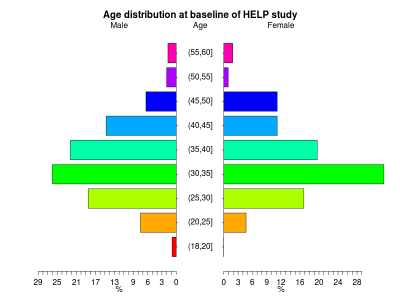I aiming to draw a pyramid plot, like the one attached.
I found several example using ggplot, but I am still struggling with the adoption of my example to my data (or the data that I want to plot).
structure(list(serial = c(40051004, 16160610, 16090310), DMSex = structure(c(2,
2, 2), label = "Gender from household grid", labels = c(`No answer/refused` = -9,
`Don't know` = -8, `Interview not achieved` = -7, `Schedule not applicable` = -2,
`Item not applicable` = -1, Male = 1, Female = 2), class = "haven_labelled"),
dtotac = structure(c(-9, -9, -8), label = "DV: Total actual hours in all jobs and businesses", labels = c(`No answer/refused` = -9,
`Don't know` = -8, `Interview not achieved` = -7, `Item not applicable` = -1
), class = "haven_labelled")), row.names = c(NA, -3L), class = c("tbl_df",
"tbl", "data.frame"))
How can I convert my data and to draw the back-to-back plot? Or how to define the Gender and dtotac variables without subseting?
The code that I am using
library(ggplot2)
library(plyr)
library(gridExtra)
SerialGenderWorkN <- data.frame(Type = sample(c('Male', 'Female', 'Female'),
11421, replace=TRUE),
dtotac = sample (0:60, 11421, replace=TRUE))
WrkFactor <- ordered(cut(SerialGenderWork$dtotac,
breaks = c(0, seq(20, 60, 10)),
include.lowest = TRUE))
SerialGenderWorkN$dtotac <- WrkFactor
ggplotWrk <- ggplot(data =SerialGenderWorkN, aes(x=dtotac))
ggplotWrk.female <- ggplotWrk +
geom_bar(data=subset(SerialGenderWorkN, Type == 'Female'),
aes( y = ..count../sum(..count..), fill = dtotac)) +
scale_y_continuous('', labels = scales::percent) +
theme(legend.position = 'none',
axis.title.y = element_blank(),
plot.title = element_text(size = 11.5),
plot.margin=unit(c(0.1,0.2,0.1,-.1),"cm"),
axis.ticks.y = element_blank(),
axis.text.y = theme_bw()$axis.text.y) +
ggtitle("Female") +
theme(plot.title = element_text(hjust = 0.5)) +
coord_flip()
ggplotWrk.male <- ggplotWrk +
geom_bar(data=subset(SerialGenderWorkN,Type == 'Male'),
aes( y = ..count../sum(..count..), fill = dtotac)) +
scale_y_continuous('', labels = scales::percent,
trans = 'reverse') +
theme(legend.position = 'none',
axis.text.y = element_blank(),
axis.ticks.y = element_blank(),
plot.title = element_text(size = 11.5),
plot.margin=unit(c(0.1,0.2,0.1,-.1),"cm")) +
ggtitle("Male") +
theme(plot.title = element_text(hjust = 0.5)) +
coord_flip() +
xlab("Work Hours")
## Plutting it together
grid.arrange(ggplotWrk.male, ggplotWrk.female,
widths=c(0.4, 0.4), ncol=2)
And this is the output
How can I move the "Work hours" to show between the "Male" and "Female" plots?




